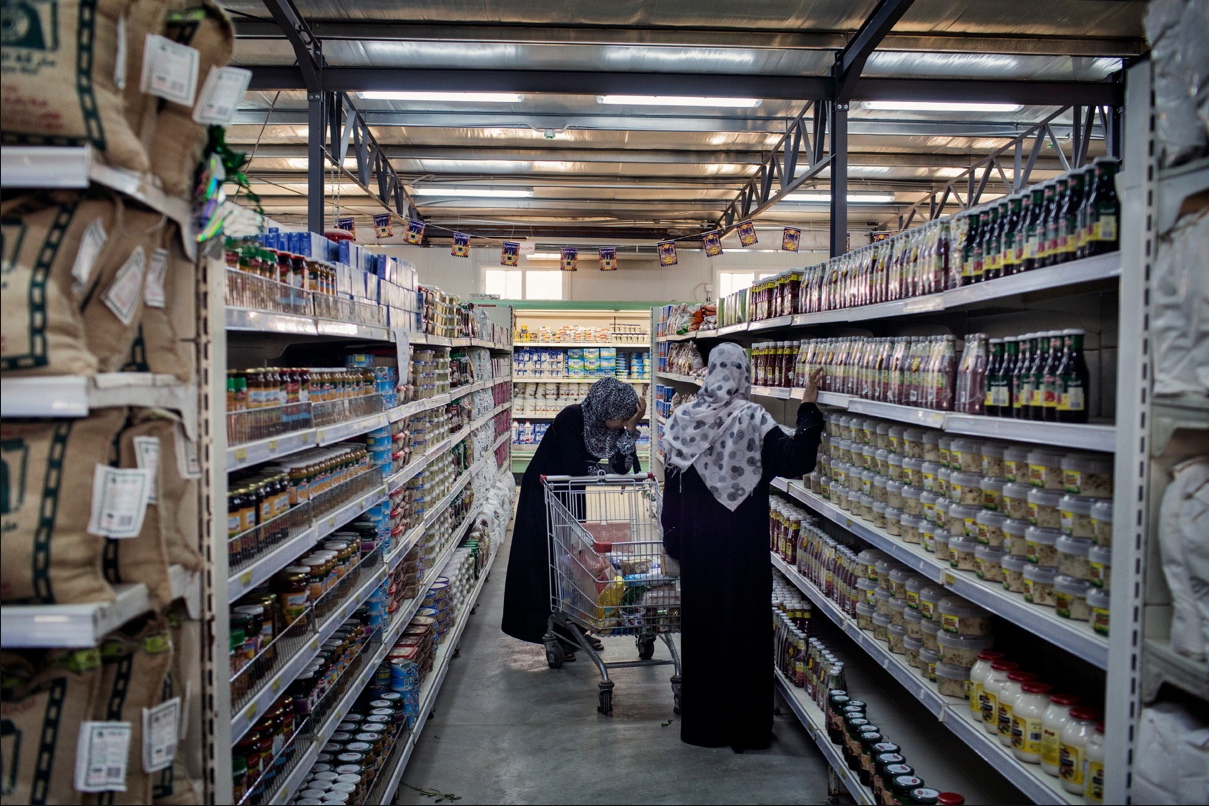It seems the New York Times has a thing going for the Zaatari refugee camp in Jordon. Along with regular reports, they’ve provided an interactive graphic and a multimedia feature story on camp growth. The stories always include attention to the considerable suffering involved in getting there and living there, and to the resourcefulness of the people in adapting to their difficult circumstances. You would never have described the reportage as upbeat, but that may be changing. The latest report was titled “Refugee Camp Evolves as a Do-It-Yourself City,” and it was pretty clear that we may be looking at a model development–indeed, an “urban incubator” that has exciting prospects for a world with 50,000,000 refugees.
The slide show accompanying the story is suitably banal, but this photo did a good job of capturing the deep ambivalence that I think lies beneath that narrative. Supermarket shelving stocked to the brim with packaged foods is one of the stock images of the abundance provided by modernization. Indeed, I never get completely past marveling at this everyday institution, which typically will stock 45.,000 products in a single store. (As a member of the latte-drinking liberal class, I should know better than to marvel at rows upon rows of product extensions of junk food, much less making a fetish of the whole capitalist system, but I can’t help myself. Besides, it beats poverty.) In the photo above, the message should be pretty clear: they have it pretty good, all things considered.
OK, they do, and it sure beats being crushed in the queue for the food truck, which is what we’ve seen in too many other camps. And I can’t help thinking that the woman behind the cart is laughing, whether at a joke or the act of being photographed, which either way would be another type of abundance. She may simply be avoiding the camera, however, or even overcome with worry or discouragement. Whether wanting privacy or more than that, the sense of privation is picked up bot the empty spaces behind the products lined up on the shelves. And despite the basic conformity with supermarket design around the world, that ceiling is too low, the lighting too spotty: this is not the same as getting that high-end store in the new urbanist development near you.
And, by the way, they are refugees. They have fled a war that is destroying the real cities where they and their families had lived, perhaps for generations. And nothing that happens in the camp is likely to have any effect on the outcome of that war. They are coping, but here that means dealing with effects, not causes; being resourceful, but not being able to believe in a viable future; getting by, but still dependent on the kindness of strangers.
Hence the ambivalence. Zaatari is not a good solution to the problems that created the refugee crisis, but it may be the best option for coping with that crisis. More to the point, there is a lot there that Jane Jacobs would like, and that therefore might be a basis for thinking about urban politics not only in the camps or the Global South but everywhere. But I can’t believe that will address the root problem, which is that war is expanding across too many countries and displacing far too many people.
Boosterism aside, the Times article is well written and makes a very important argument. If ordinary people are given the opportunity to turn a camp or a slum or any other disaster zone into a city, they will do that. (Detroit, are you listening?) Life, not merely bare life, will grow like weeds. As cities always do, prosperity and culture will be created and shared. The people thinking about refugee camp management are right to be valuing the achievement on the ground at Zaatari. “A number of forward-thinking aid workers and others are looking at refugee camps as potential urban incubators, places that can grow and develop and even benefit the host countries.”
So we get to what might be a distinctive form of urban development in the 21st century. Can host countries create new cities out of the camps that are being created by the wars that are wrecking other cities and other countries? It’s a rotten question, but it seems to be one we need to face.
No city has to have a noble beginning, but the question of where it will end should not be taken lightly.
Photograph by Adam Ferguson/New York Times. It turns out that I have a thing for Zaatari too. I’ve posted on it twice before: here and here. I wouldn’t say those posts are out of date, but the story continues to evolve.

Discussion